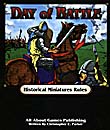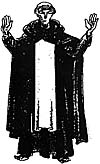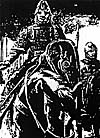Chapter One-Der
Day of Battle
Introduction
Miniature rules for Feudal Warfare
By Christopher Parker
© 1997 and Reprinted by Permission of Publisher
All About Games Publishing
| |
The rule book that you hold is a miniatures army-role-playing game set in Western Europe during the Feudal period. If you haven't tried a game like this before, you're in for a special time. You and one or more friends gather round a table covered with miniature soldiers, dice, model scenery and your active imaginations and take on the roles of player characters called leader's. Each one of you will try to complete your leaders goals, defeat scurrilous enemies, gather honor and attempt to avoid being captured and held for ransom, or worse, killed. Think of your leader as a character out of a book or a movie, acting out mighty deeds or feats of arms for all to see. With some imagination, and a little luck, your leader and his stalwart army will pull through to do battle repeatedly. As you learn the tactics of this period you will gain more victories. First Section The first section of this book, (The Knight At War) teaches you the basic and advanced rules of the game itself. How to raise, organize, command and maneuver your army and, most importantly, how to defeat your enemy are in this section. Every player should read through this part first. The second section (The Army Appendix) shows you how to raise different types of armies other than the one provided in the first section of these rules.
Besides pencils, paper and an active imagination, you will need six things to play DOB: playing cards, dice, rulers, poker chips and of course miniature figures. Dice Since DOB is a game, we need a way of randomizing how well your archers are going to do against the knights thundering down on them. We accomplish this with dice. These dice are ten (D10) and twenty (D20) sided. If there is a number in front of the die such as 3D20, it means to should roll 3 twenty-sided dice. Though you roll the dice together do not add these up. A D10 has a 0 on it. Which is read as 10. If you should need some dice you should be able to find them at any good game store, like the one that sold you this game. Playing Cards DOB uses a normal deck of 52 playing cards. Each side should have it's own deck, which is shuffled at the beginning of each game turn. The cards themselves represent the following values. Ace: 1, 2-10 as is, Jack, Queen, King: 5, Joker: Special. Measuring Devices You may always measure before playing. You will want to use a ruler marked in inches if you are playing with 20-25mm figures. However the 15mm scale is becoming increasingly popular. For this reason the game includes a special, reduced 15mm ruler on page 28. Poker Chips DOB uses poker chips to keep track of different events that happen during the game. You'll need about 50. For the present all you need to know is that white is 1, red is 5 and blue is 10 points. Thes are used to keep track of honor points and units that act our of turn. Both of which will be explained later in the rules. Miniature Figures Each player will need an army of 50-100 figures. Ral Partha makes an excellent line of true scale-25mm Medieval figures. Miniature Figurines USA makes both true scale-15mm and 25mm Medieval figures. If you can't find these at your game store send for a free catalog to The Toy Soldier 3.0, PO Box 1201, Plaistow NH. 03865. Reading The Dice Any rule in the game that requires a die roll will list the highest number you will need to roll. This number may be modified. The resulting number or less will mean a successful roll. This modified number is referred to in the rules as the target number (TN). Incidentaly, a roll of 1 is always successful, and a roll of 20 always fails. Rounding There is one universal rule in DOB, round down. That is all you have to remember. If you have a value of 15 and a modifier calls to halve it, round it down to 7, get it, great! The Stuff Warriors Are Made Of
2. Esteem 3. Motivation 4. Skills Step One: Social Rank (SR) In the Medieval world every knight, indeed every person had his place on the social ladder. Draw a card for the SOCIAL RANK TABLE. * A joker requires a second card. Face = Great King, number = Common. Step Two: Esteem A Leader's esteem determines the minimum command a leader must have to maintain his standing in the eyes of his peers. Draw a card and add the leaders SR to the card to determine his Esteem.
This is probably a young or untried leader. He has little authority and no minimum command.
This person is an up-and-coming leader. He must command at least 1 unit of knights.
This leader is recognized by most of his peers as a leader of worth and quality. He must command a battle line, explained later.
This leader is recognized by one and all as a person to aspire to emulate. He must be the army commander unless there is an extraordinary leader present.
This is the greatest of leaders. All others respect and admire him. None will argue with him; his word is law. He must be the army commander, stepping aside only (and grudgingly no doubt) for a higher SR leader. Loss Of Esteem At the end of a battle a L&H that was unable to meet his minimum level of command as determined by his esteem loses 50% of any HP gained during the battle. Climbing The Social Rank Ladder As a L&H EST rises so may his SR. Each time his EST increases a level draw a card, if =/+ than 2 x his SR his SR will increase 1 level. Special Card: Joker If this card is drawn set it aside for use after the leader is finished and draw another card in its place. The joker allows the swopping of any two leader attributes or skills. Ex: A low SR card could be exchanged for a high skill card. Step Three: Motivation The next step in creating your leader is to know what his motivation is in life. There are three types: Chivalric, Mercenary and Raider. A leader gains the most honor when he performs actions matching his motivation. Types Of Motivations Draw 1 card to determine a leader's motivation.
5 Mercenary (MRC): This leader is a professional soldier. He is a warrior for the sake of war itself; it is his trade. He will usually serve under any master who will pay. This leader could be a noble or commoner, rarely clergy. His Esteem is increased primarily by surviving battles and proving that he can provide or command other mercenary units well. 6-10 Chivalric (CHV): This leader is motivated by God, country and righteousness. He is probably a knight or a member of the church. Step Four: Skills Draw 4 cards, and assign one to each of his skills.
Morale (MB) 1-10 points. This skill modifies a unit's morale grade when the leader is attached. More on morale later. Combat (CB) 1-10 points. When a leader is attached to a unit in a melee he rolls a bonus die. This represents his and his bodyguard's. This bonus modifies the TN for his bonus die. This will be explained later under combat. Personal Combat Skill (PCS) 1-10 points. This number is increased by +10 to give a value of 11-20. The leader's ability to survive combat. More on this under risk to a leader. RelatedBack to Chapter One-Der Historical Rules List Back to Master Chapter One-Der List Back to MagWeb Master Magazine List © Copyright 1997 by Coalition Web, Inc. This article appears in MagWeb (Magazine Web) on the Internet World Wide Web. Other military history articles and gaming articles are available at http://www.magweb.com |
 Greetings, milords and ladies, you are indeed most welcome to the world of Day Of Battle, a strange, turbulent place and time.
Greetings, milords and ladies, you are indeed most welcome to the world of Day Of Battle, a strange, turbulent place and time.
 A time when personages of all social levels struggled to survive in a violent political, religious and military world. I am Brother Robert. I will act as your guide through this tome.
A time when personages of all social levels struggled to survive in a violent political, religious and military world. I am Brother Robert. I will act as your guide through this tome.
 The Weapons Of War
The Weapons Of War
 Leaders represent the great man, his personal staff and bodyguards. Creating a leader in DOB is easy; just copy the Leader Profile Card (LPC) from the Army Appendix and follow along as I show you how to create a leader. If you don't have the time or the inclination to do this you'll find ready made leaders on page 6. You'll need to give your leader a name, but otherwise he is ready to go. To create your leader follow these 4 steps:
Leaders represent the great man, his personal staff and bodyguards. Creating a leader in DOB is easy; just copy the Leader Profile Card (LPC) from the Army Appendix and follow along as I show you how to create a leader. If you don't have the time or the inclination to do this you'll find ready made leaders on page 6. You'll need to give your leader a name, but otherwise he is ready to go. To create your leader follow these 4 steps: